|
|
Gallows Hill: Where Were the Witches Hung?
Salem, Massachusetts
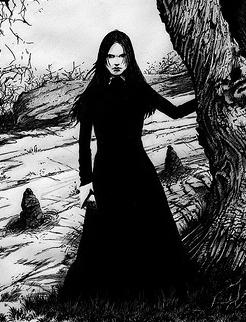
Field Investigation:
19 December 2006, 19 November 2006, 4 October 2003, 12 July 2003
by Daniel V. Boudillion
|
Note: this is the full
text of the abbreviated version published in the book Weird Massachusetts
Introduction
The story of 18 people
accused as witches in the 1692 Salem Witch Hysteria ends as victims at
the end of a hangman’s rope on Gallows Hill, otherwise known as Witch
Hill or Witchcraft Hill. You would think such a public and awful
event at that spot would have made such a huge impression on people that
the location would live forever if only in infamy. Yet today, the exact
location of the hangings, and even which hill is Gallows Hill, is not
precisely known.
The town of Salem did set aside
a public park but there is still historical debate about the location of
the site and the clues lead elsewhere. Let us see where those clues
lead.
On the Road with the Salem Witches
 Many
years ago as a young man I traveled the country for a year. With me I
brought a number of books to keep me occupied, and included were several
volumes on the Salem Witch Hysteria. These were fascinating accounts of
the bitter land-feuds and ministerial issues that polarized Salem
Village. This was to erupt in 1692, with a supernatural twist, into a
seething cauldron of persecutions, accusations, and executions. Many
years ago as a young man I traveled the country for a year. With me I
brought a number of books to keep me occupied, and included were several
volumes on the Salem Witch Hysteria. These were fascinating accounts of
the bitter land-feuds and ministerial issues that polarized Salem
Village. This was to erupt in 1692, with a supernatural twist, into a
seething cauldron of persecutions, accusations, and executions.
The entire drama captured my
imagination and upon returning to New England, I visited Salem to see
the locations of the many events. High on my list was Gallows Hill.
Little did I realize it would be 20 years or more before I stood on the
actual place where the hangings occurred.
Salem Town: Witches Old and New
Although I grew up in Middlesex
County, I had never been to Salem in adjoining Essex County until I went
on my pilgrimage there. Driving in on Lowell Street from Peabody
Center, I crossed into Salem at the Old South Cemetery. Here a sign at
the town line informed that I had entered The Witch City. What were
they trying to say by that, I wondered?
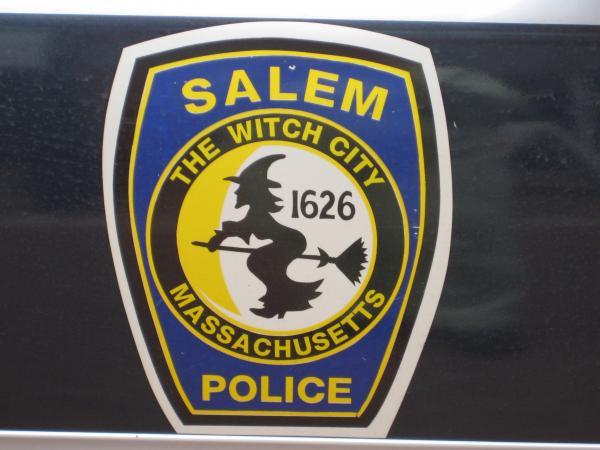
Door of Salem Police Car
By the time I got to Salem
Common and had a walk around, I knew. Salem had made a
tourist trade
off the Hysteria, even though virtually all the characters and action in
1692 took place in Salem Village, which was renamed Danvers about 50
years after the hangings. Salem Common was a dangerous place. It was
where everyone walked their dogs, and back then there was no such thing
as "scooping." I quickly renamed the place Dog Poop Park, a
name that has stuck long after the town bylaws have changed to address
that situation.
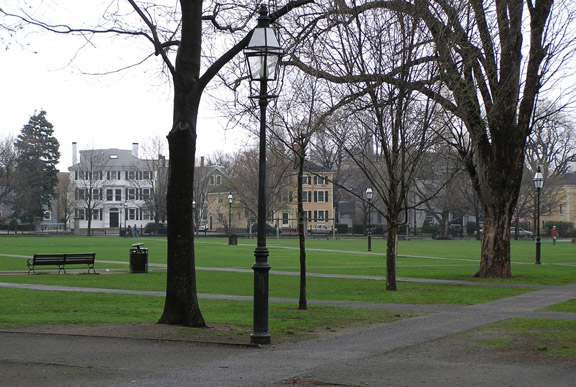
Salem Common
Watch your step!
There was a terribly tacky Witch
Museum in a wonderfully old gothic building. I walked in and promptly
walked out. Around the corner was Laurie Cabot’s Crow Haven Corner. In
case you don’t know, Laurie Cabot is Salem’s official Witch. It was an
interesting little shop in a spooky old Colonial house. The ambiance
alone was worth every penny of the herbs I bought to be polite.
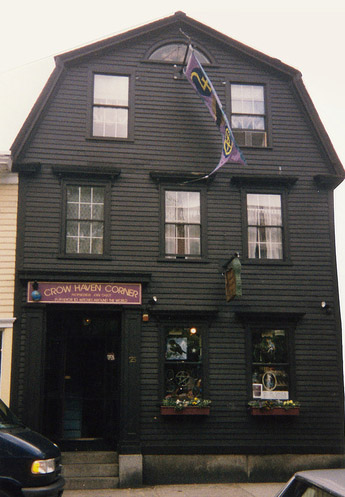
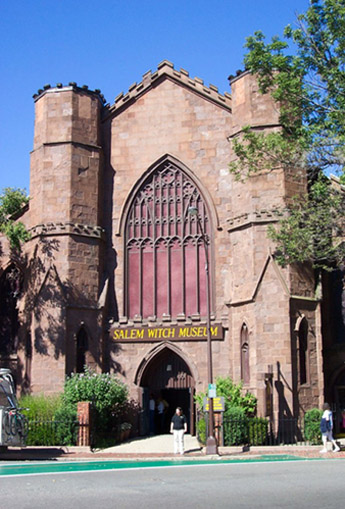
Crow Haven Corner & Salem Witch Museum
The Salem Common and Pickering
Wharf area were a co-mingling of historical Witch Hysteria sites, and
modern Witch and New Age shops.
Is This Gallows Hill?
As delightfully "witchy"
as the Salem Common area turned out to be, I directed my steps to
Gallows Hill. The directions I had led me to a park near Proctor
Street, near the intersection of Boston and Bridge Streets. The park
was named Gallows Hill Park and a nearby water-tower had a large
official witch riding a broomstick painted on the side.
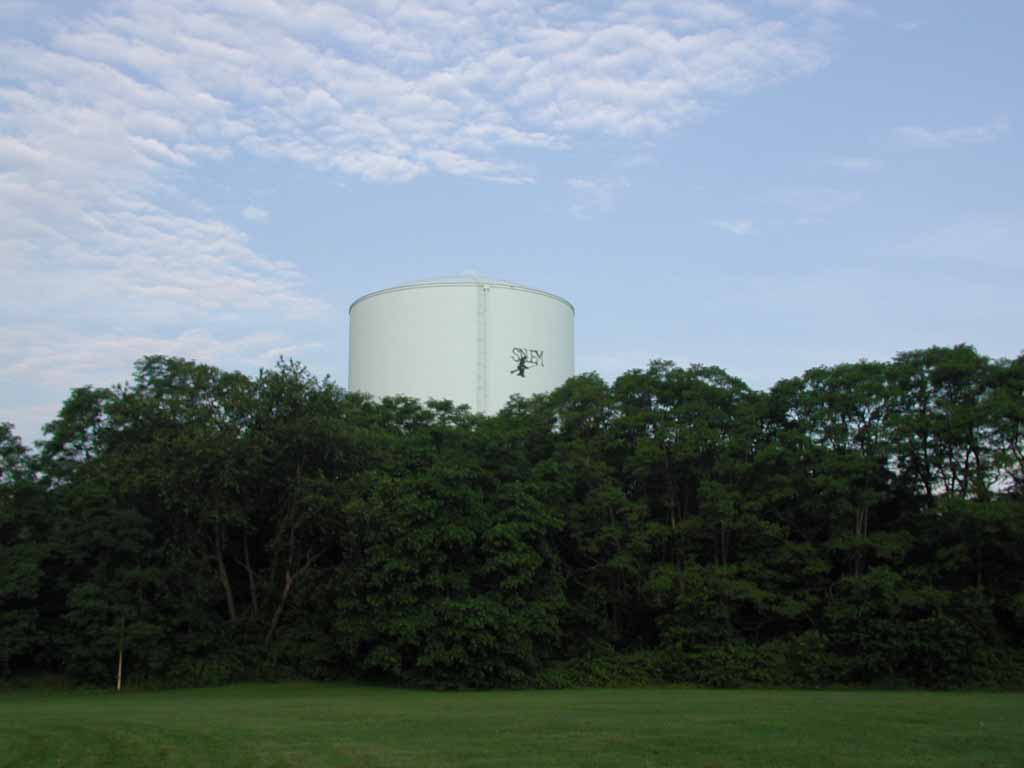
Salem water-tower with Witch Logo
click for
close-up
This must be the place. I
walked up the hill to the official "hanging spot" and looked
around. The view was magnificent. But although it was an impressive
location, and even a satisfying one, it simply did not line up with the
facts I had learned from my reading.
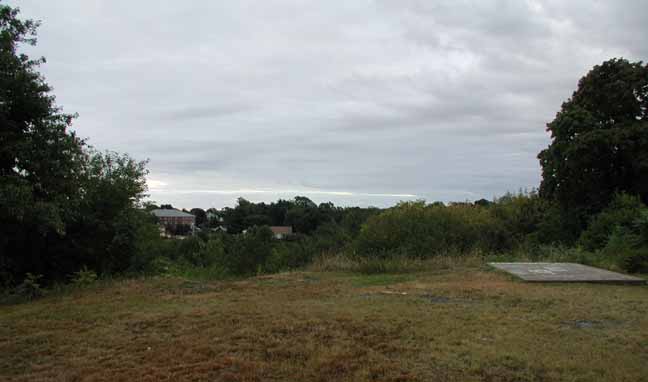
Official Hanging Place on Official
Gallows Hill
For one thing, the hill was
steep, and the thought of the accused being transported to the top in a
cart, as it is known they were, seemed ludicrous upon having ascended
the hill myself. Also, I had learned that Benjamin Nurse had rowed a
boat from a creek near the Nurse Homestead, out into the North River,
and then to the base of Gallows Hill to recover his mother’s body. It
only took one look to see that there was no waterway contingent to the
North River at the base of the hill I was standing on. There was no
water at or even near the base of the hill The closest water was a
canal over a quarter mile northeast.
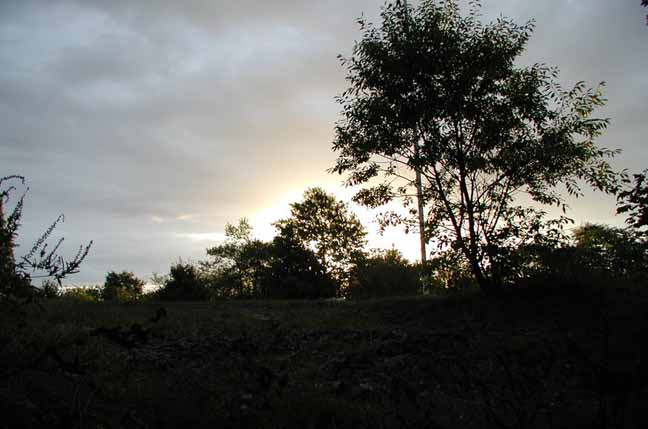
Sunrise at Official Gallows Hill
This left me confused. In my
opinion, the hill simply did not square with the historical record. I
left feeling misled and puzzled over it occasionally in the ensuing
years, but with no better understanding.
Salvatore Trento Takes a Stab
Twenty years later I bought
Salvatore Trento’s Field Guide to the Mysterious Places of Eastern
North America and was intrigued about this once again. Trento
asserted that the official Gallows Hill was not the correct location,
much as I had suspected. He proposed a nearby hill as the site,
complete with crevasse and gallows footing stones.
So off I went in July of 2003 to
locate this hill. I found it easily enough south of the playing fields
in Gallows Hill Park, and about 200 yards Southwest of the water tank.
It is a low grassy hill sloping down on its southern end. The north end
was a knoll
with a crevasse just over the side (history tells us the bodies
were dumped in such places). The hill even had
easy cart
access up the south side from Colby Street, which looked liked
it may have been a road back in the hanging times.
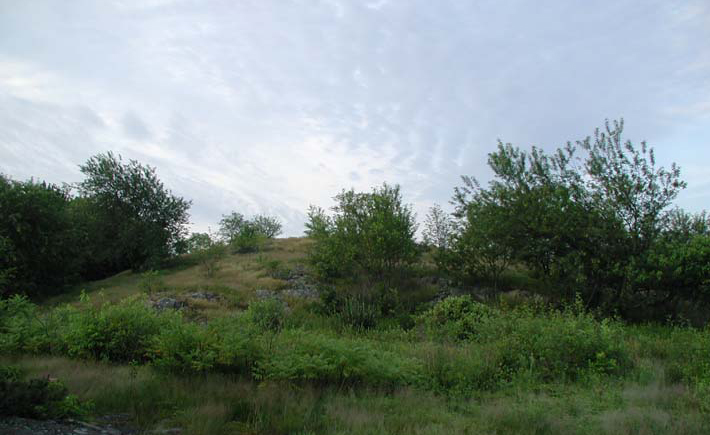
Trento's Gallows Hill
I was pleased with this
discovery, but the fact that this hill was even farther away from the
closest waterway to North River was disconcerting. It was over a half
mile to the canal in fact. I wondered how Trento reconciled this fact
with the site’s location.
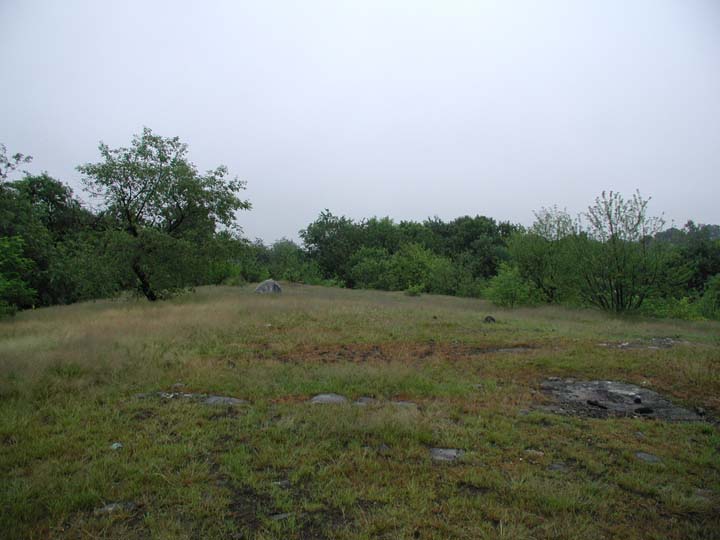
Top of Trento's Gallows Hill
So I went back to the books and
refreshed my grasp of the known facts. Several things immediately
invalidated the Trento site. First, he says the footing stones for the
gallows are still visible. I have seen
the stones he
talks about, but the problem is that the accused were not hung
on a gallows. Rather, they were hung from the branches of trees.
Researchers have combed the meticulous records of the trial era, and not
one mention was found of a gallows, and more tellingly, there is no
record of the cost to purchase wood and construct such a gallows.
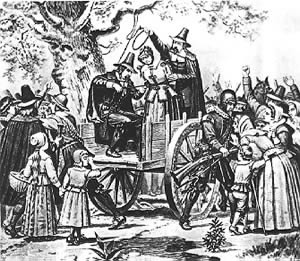
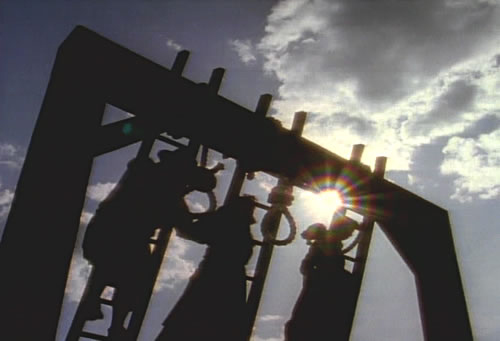
Correct and Incorrect Salem Witch
Hanging Depictions
Also, the accused were brought
to the top of the hill in a cart. Although that is quite doable at the
Trento site, the approach is from the Colby Street area, and it is known
that the actual route went over Town Bridge at what is now the
intersection of Boston Street and Bridge Street, and thence up the
hill. The Trento site does not fit with this fact either.
Disappointed, I determined to
find out once and for all the actual location.
Collective Amnesia
The more I researched and
investigated, the more apparent it become that the official Gallows Hill
site is only a probable site. Rev. Charles Upham chose what is known
today as Gallows Hill as the probable hanging site in his 1867 book
Salem Witchcraft. Historians and officials have followed his lead
ever since, even though in Upham’s own words, "There is no
contemporaneous nor immediately subsequent record that the executions
took place on the spot."

Upham's Gallows Hill
By the time of Upham’s writing,
the actual site, wherever it was, had dropped from public
consciousness. The entire hanging episode was an acute embarrassment
and shame to the community, and although the site was known to people,
it was not publicly proclaimed or celebrated. Rather, the subject, and
therefore the location, was avoided and a kind of collective amnesia
occurred in regards to the location. People simply wanted to forget,
and thus the location was "forgotten" too.
However, it doesn’t help the
tourist trade in modern Witch City to not have a true location of
Gallows Hill. Let the scholars argue as they will, but the hill that
Upham chose has become the agreed-upon location for pragmatic ends, if
nothing else.
The Perley Hypothesis
Fortunately, there are a number
of scholars and researchers who have made a thorough examination of the
facts and have come to conclusions more consistent with the historical
record.
The most thorough and convincing
presentation was made by Sidney Perley in 1921. Like other researchers
since, Perley was unable to "discover any tradition or other
evidence which indicates that the alleged witches were executed on top
of [Uphams’] Gallows Hill; and it is unreasonable in every aspect of
consideration that they were."
Perley did discover a number of
important clues. He was able to reconstruct the landscape and land
ownership of Salem at the time of the hangings, making a number of
maps. A final and composite map of Salem circa 1700 drawn from his work
was assembled by William Freeman and published in 1933.
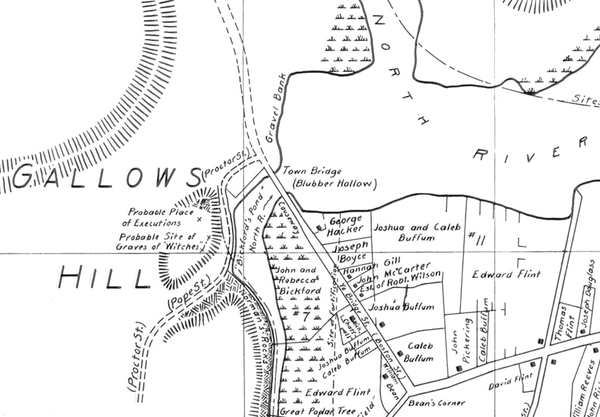
Freeman's 1933 map based on Perley of
1700 Salem showing actual Gallows Hill
click for same
map oriented to north
Perley was also in possession of
a letter written by Dr. Holyoke in 1791 with the following passage: "In
the last month, there died a man in this town by the name of John
Symonds, aged a hundred years lacking about six months, having been born
in the famous ’92. He has told me that his nurse had often told him,
that while she was attending his mother at the time she lay in with him,
she saw, from the chamber windows, those unhappy people hanging on
Gallows Hill, who were executed for witches by the delusion of the
times."
Perley was able to locate the
house Symonds was born in and found that it was impossible to see the
supposed hanging site on the southern end of the hill, let alone Gallows
Hill. Ledge Hill completely blocks the view. However, a nearer lower
hill that better fits the facts of the circumstance was well in view.
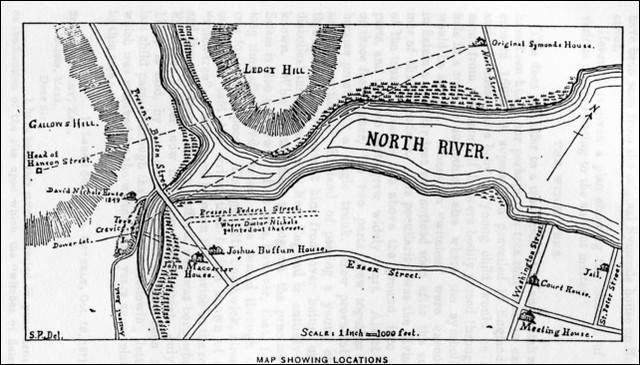
Pearly's map showing actual Gallows
Hill and Symonds sightlines
click for same
map oriented to north
The known route from Salem to
the hanging site is from Prison Lane (now St. Peter Street), then the
long ride down Essex Street, thence a short ride on Bridge Street (now
Boston Street), and over Town Bridge and then left to the hill.
Town Bridge (now the Junction of
Boston and Bridge Streets) was the recognized limit of the town in
1692. The Sheriff of Salem, George Corwin, was given the authority to
choose the execution location, the only stipulation being that it be
done outside of town. Immediately upon crossing Town Bridge, the lands
to the left (including the official Gallows Hill) were all Common
Lands. Salem was built on a peninsula of land. The only road out of
town at the time was over Town Bridge. Thus Corwin would have taken the
condemned at least over Town Bridge. Perley believes that Corwin did
so, but no further. Perley believes that Corwin took the immediate left
after the bridge onto Proctor Street, at that time only a cart road
skirting a low hill, and deposited the condemned at this little hill for
execution.
This site fits all the known
facts. First, it is over the town line. Second, it is easily
accessible by cart. Third, the hill was of sufficient height that Salem
was observable from it, a noted fact. Forth, at the time, the North
River extended in a large bay all the way to Town Bridge. The modern
canal is simply all that is left of the bay after it was filled in. In
1692 the Town Bridge crossed a small arm of the North River bay called
Bickford’s Pond. Bickford’s Pond abutted the small hill. This fits
with the story that Benjamin Nurse was able to row his boat all the way
to the base of the hill. Fifth, the small hill supported substantial
trees, whereas Upham reports of the official Gallows Hill site that the "scattered
patches of soil are too thin to tempt cultivation." Thus no trees,
and recall that there is no evidence of an actual gallows erected - so
how were they hung, then? Sixth, the hill may be plainly seen from John
Symonds’s birthplace, exactly as his nurse said.
Evidence of the Locust Trees
In 1747 locust trees had been
planted in the area. According to President John Adams, who visited "Witchcraft
Hill" in 1766, "Somebody within a few years has planted a
number of locust trees over the graves, as a memorial."
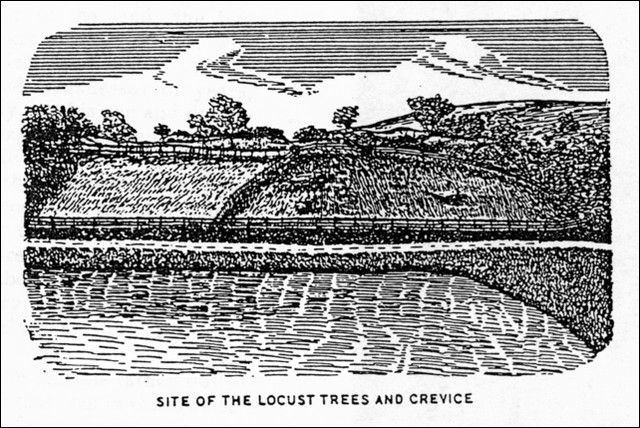
Perley's sketch of actual Gallows Hill
Adams was incorrect about them
being a memorial, however the clue of the locust trees led Perley to
inquire of the owner of the small hill if locust trees had ever grown
there. Indeed they had, although recently cut down. No locust trees or
memory of locust trees were found on Upham’s choice of Gallows Hill.
The Witch Tree
An interesting side note is that
there was a so-called "Witch Tree" on the Perley site as late
as 1793. This tree was not connected with the hangings, but was rather
of an odd shape. It divided a foot or two above the ground into two
trunks that then grew wildly apart, only to reunite into a single trunk
several feet higher. It was the custom among some Salem residents
sometime after the hysteria to pass new-born babies through the hole to
protect them from witches.
Rowing Rebecca Home
Nurse family tradition is that
when Rebecca Nurse was hanged on July 19, 1692, that her youngest son
Benjamin, then 26 years old, rowed his boat under cover of darkness from
the Nurse homestead to Gallows Hill to retrieve her body. This is not
as impossible as it might seem, even though it was a 6 mile one-way
trip. For one thing, it was not unusual for Salem Village farmers to
row into Salem Town.
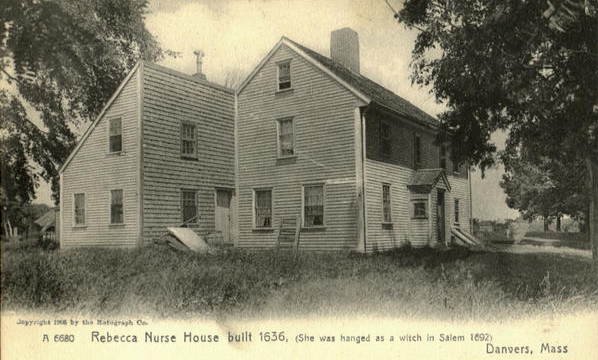
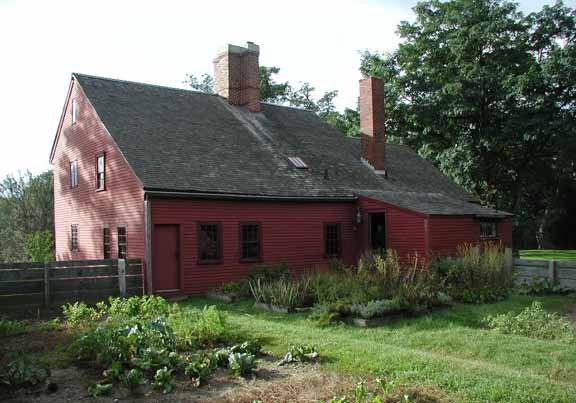
Rebecca Nurse House
The route Benjamin would have
taken started from Crane Brook on their property, passing east under
Hadlock’s Bridge, then further east under the Crane River Bridge on
Ipswich Road, and out into the Crane River proper, a tidal bay. He
would have continued rowing east to where the Crane River joined the
Wooleston River, another tidal bay. He would have turned South into the
North River near Skerry’s Point in Salem Town were they original lived
before buying the farm in Salem Village. Down the North River, a tidal
bay, he rowed, then under Town Bridge and into Bickford’s Pond.
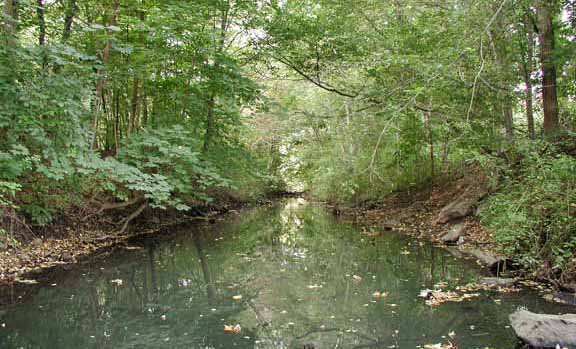
Crane Brook behind the Rebecca Nurse
House
Proctor Street occupied the 20
foot wide flat between the pond and the hanging hill, which rose about
30 feet high. Rebecca’s body was dumped in a crevasse on the face of
the hill. He would have retrieved her body from the crevasse and rowed
back to the homestead where his older brother Samuel (who had adjoining
property) and father Francis buried her in an unmarked grave.
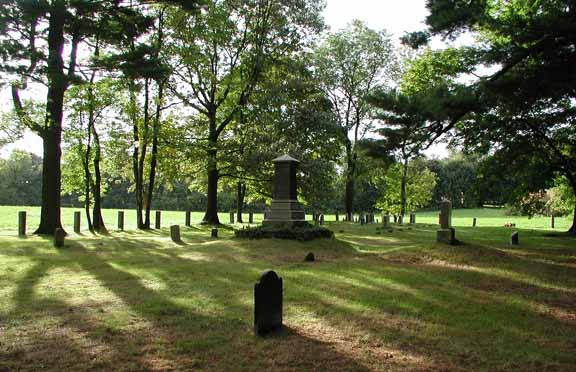
Nurse family Cemetery
Will the Real Gallows Hill Please Stand Up
I had a feeling years ago that
something was not right with the official Gallows Hill location. It
didn’t square with the facts as I knew them. The alternative location
that Trento proposed had even more historical problems. It wasn’t until
I worked on Perley’s material that I felt a proposed location fit the
known facts. It’s my opinion that Perley is the only one so far that
has produced a location for Gallows Hill that is convincing. Perley’s
work seems historical proof enough, certainly more then Upham’s, but it
has no official recognition. Perhaps because a Walgreens occupies the
site and it’s not a very tourist friendly location.
Witchcraft Hill
On November 19, 2006, I visited
the Perley site. It is located at the junction of Boston, Bridge, and
Proctor Streets. This intersection was actually Town Bridge three
hundred years ago. From here, turn onto Proctor Street. Today Proctor
Street curves up behind the hill, but back in 1692 it curved in front of
the hill. In any event, the hill is behind the Walgreens and the
parking lot butts up against it. Proctor Street used to curve along it
face between the hill and the pond. Walgreens is where the pond used to
be. The Witch Hill GPS coordinates are:
42.5180N, -70.9100W.
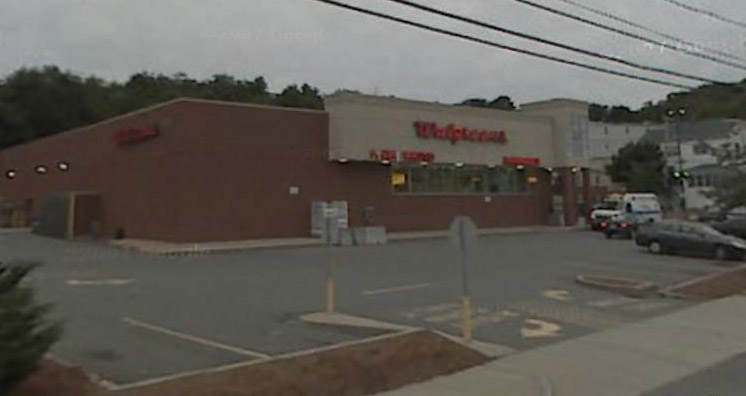
Walgreens at the Corner of Bridge &
Proctor
GoogleEarth Image
You will notice that the face of
the hill behind Walgreens is steep and rocky. This is due to a
since-removed railway that was put through along the base of the hill in
the 1870’s.
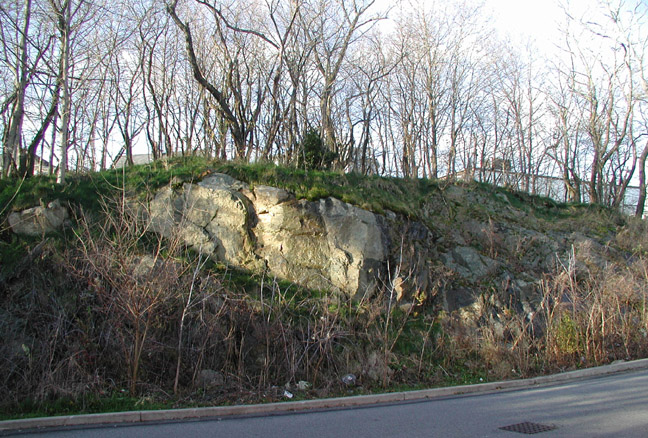
Base of hill behind Walgreens where the
railroad was.
The digging and blasting changed
the face of the hill from a smooth grassy slope to the current bedrock
and steep ledge.
The hangings took place on the
flat of the hill directly behind and overlooking the parking lot near
the hill’s northeast end. This area is now a small grove of young trees
in a Proctor Street resident’s backyards.
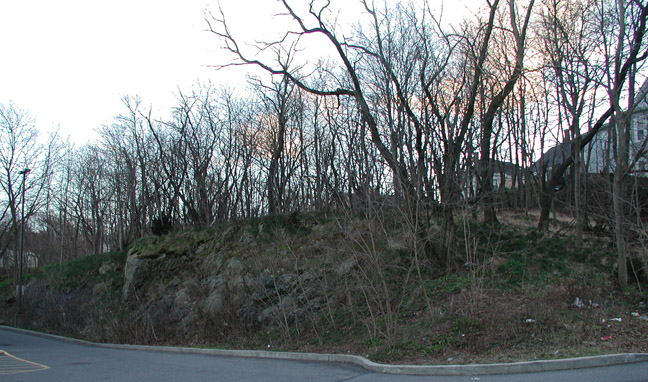
The hangings were on the top of this
knoll, in the center of the picture.
Here is the same location seen from the
extreme far left of the above picture:
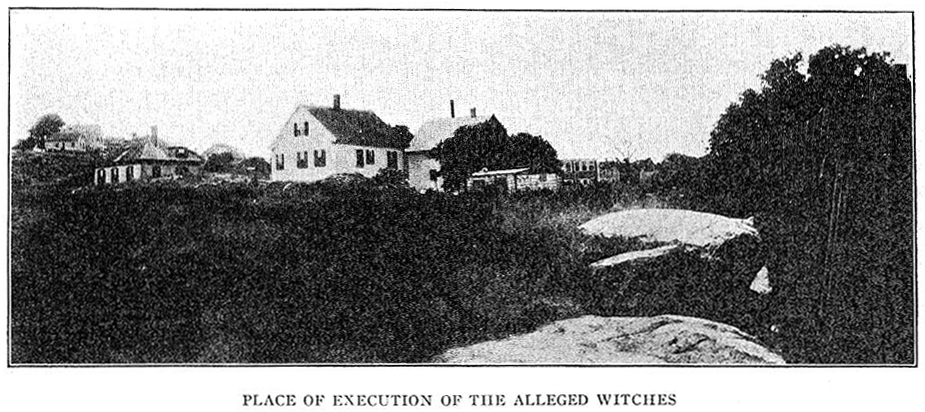
Actual Gallows Hill location from
Perley's History of Salem
Note the "official" Gallows Hill high
above in the upper left side of picture
Click
here for same view today
(photo courtesy of Eric Lawison)
The crevasse is further down the
length of the hill, near where Pope Street turns left past the Walgreens
parking lot. The actual location appears to be in someone’s side yard.
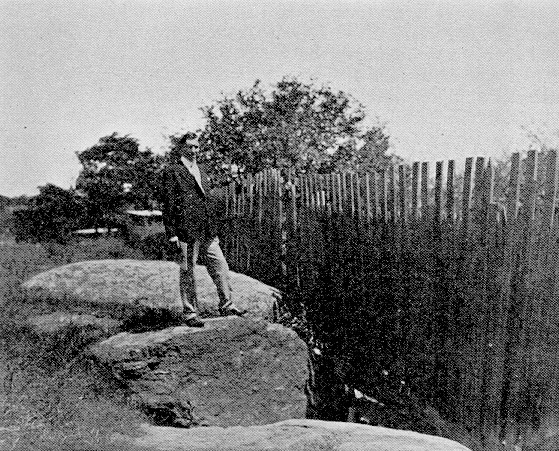
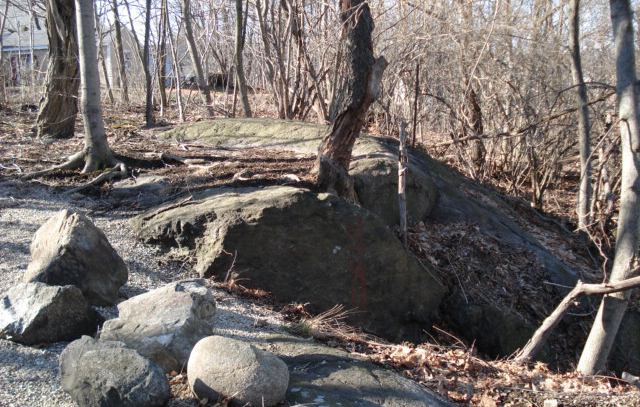
Crevasse in Perley's History of
Salem (1924) and in 2009 by Eric Lewson
Photograph courtesy of Eric Lewison
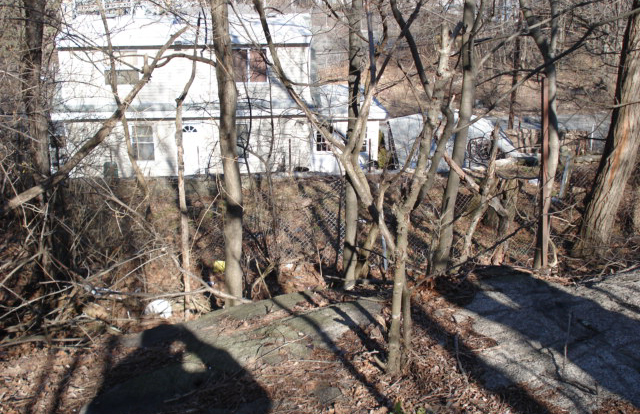
View From Where the Witches were Hung
Photograph courtesy of Eric Lewison
At first appearance it is not an
obviously spectacular or evocative location. But the little tangle of
oddly twisted trees at the top is a witch’s woods of sorts.
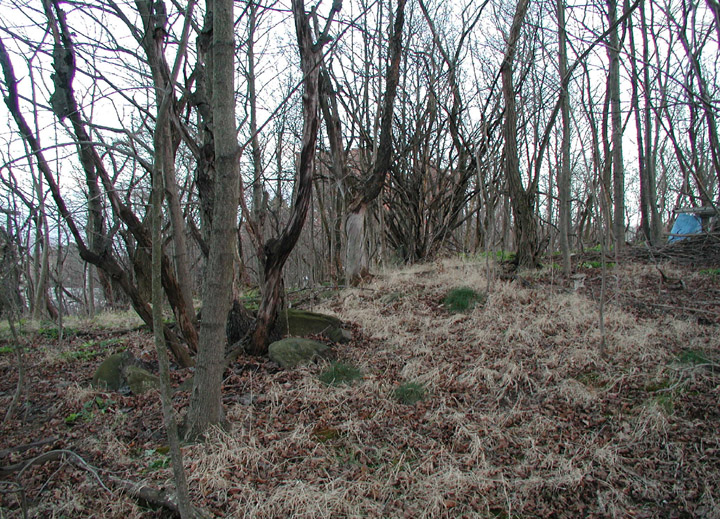
The hangings were here in this "witch's
woods."
Some quiet moments I spent there
in early morning contemplation were revealing, however. I had no sense
of the deaths that occurred here, however, I had a sense of the
collective amnesia of the place. It is a place hidden, forgotten, and
shunned. An embarrassment and shame of a community. There will be no
markers placed here. All it wants is to be forgotten.
If you visit, say a prayer for
the accusers, not the accused, it’s their pain that lingers here.
Email Daniel V.
Boudillion
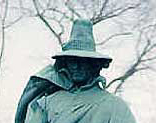
Back to Field
Journal
Copyright © 2007, 2009 by Daniel V. Boudillion
| 
 Many
years ago as a young man I traveled the country for a year. With me I
brought a number of books to keep me occupied, and included were several
volumes on the Salem Witch Hysteria. These were fascinating accounts of
the bitter land-feuds and ministerial issues that polarized Salem
Village. This was to erupt in 1692, with a supernatural twist, into a
seething cauldron of persecutions, accusations, and executions.
Many
years ago as a young man I traveled the country for a year. With me I
brought a number of books to keep me occupied, and included were several
volumes on the Salem Witch Hysteria. These were fascinating accounts of
the bitter land-feuds and ministerial issues that polarized Salem
Village. This was to erupt in 1692, with a supernatural twist, into a
seething cauldron of persecutions, accusations, and executions. 


























